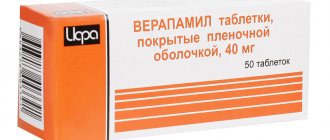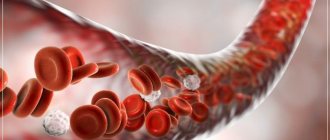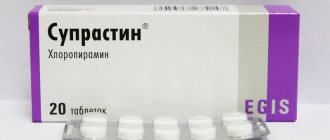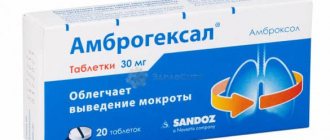- August 28, 2018
- Other drugs
- Natalia Balagurova
Oral administration of Urografin is indicated if urography is necessary. The drug is a radiocontrast agent and is based on iodine. Used strictly in a clinical setting under the supervision of a qualified doctor. Self-use of Urografin at home is strictly prohibited. Let's consider how the product is used, what effects it gives, what features it has.
What's on sale?
The product presented in pharmacies is “Urografin” in ampoules. The substance contains meglumine and sodium amidotrizoates. In 1 ml of 76% solution there is 0.1 g of sodium component and 6.6 times more meglumine. The second concentration option is 60%. For 80 mg of sodium compound there are 520 mg of meglumine. The manufacturer used special purified water for injection, sodium and calcium edetates as additional ingredients.
Urografin used internally is available in the form of a solution for injection. There are no tablets or powders, ointments or gels produced under this name. The product belongs to the class of radiopaque agents and is used if the patient needs to undergo urography. The drug is used if a retrograde version of the procedure or intravenous is necessary.
Sometimes 1 ampoule of “Urografin” is prescribed to persons in need of angiography. The substance can be used if cholangiopancreatography using an endoscope is planned, the procedure is planned to be carried out according to a retrograde scenario. It is allowed to use the drug in question to clarify the results of arthrography and increase the effectiveness of cholangiography. The medication is prescribed to persons for whom fistulo-, sialo-, and hysterosalpingography are indicated. Sometimes it is used before a number of other studies, if the doctor considers the introduction necessary.
Release form and composition
The dosage form of Urografin is an injection solution of 600 and 760 mg/ml (in ampoules of 20 ml, in a cardboard pack of 10 ampoules or 10 pieces in pallets, in a cardboard pack of 1 or 12 pallets).
Active substances in 1 ml of solution (60% or 76%):
- amidotrizoic acid – 471.78 or 597.3 mg (corresponding to 292 or 370 mg of iodine);
- meglumine – 125.46 or 159.24 mg.
Additional components (600/760 mg/ml): sodium calcium edetate – 0.1/0.1 mg; sodium hydroxide – 5.03/6.29 mg; water for injection – 725.73/653.77 mg.
Strictly prohibited
“Urografin” (76%, 60%) is not administered if increased susceptibility or intolerance by the patient’s body to iodine-containing contrast agents is detected. The composition should not be used if doctors have reason to expect such a response to therapy. It is forbidden to use the product against the background of hyperthyroidism. A categorical contraindication is insufficiency of the heart in a decompensated form.
Certain contraindications are associated with specific activities and studies. In particular, ERCP, for which Urografin is chosen, is not performed if a person has pancreatitis and the pathology occurs in an acute form. Hysterosalpingography is prohibited during pregnancy and in the presence of a focus of inflammation in the pelvic area, when the process is acute.
You cannot use Urografin (76%, 60%) for cisterno-, ventriculo-, and myelography. The restrictions are due to the increased risk of phenomena associated with toxic effects on the nervous system. The use of the composition is associated with significant risks of pain, convulsions, and coma. From experience gained in the past, it was established that the choice of the drug in question can provoke death.
Researching
For intravenous urographic diagnostics, the medicine is administered at a dose of 20 ml per 1 minute. If there is a cardiac dysfunction, the medication is administered more slowly, which takes half an hour.
An adult patient is prescribed 0.02 liters of the drug “Urografin 76” or 0.05 liters of a 60 percent drug. Increasing the amount of a drug of higher concentration to 0.05 l helps to increase diagnostic accuracy.
Photographs of the renal parenchymal tissue are taken at the end of the injection for better display. To visualize the structure of the pelvis and urinary tract, 1 photo is taken 5 minutes later, and 2 - 12 minutes after infusion of the liquid.
When using 0.1 liter of medication infusion, the duration of the procedure is from 5 to 10 minutes. For people with myocardial diseases, this amount is infused into the veins in half an hour. The first photos are taken at the end of the injection, and the next ones are taken within 20 minutes.
During X-ray examinations of the circulatory system, when aortography, angiocardiography or coronary angiography is performed, high dosages of the drug “Urografin” are used. The use of a 76% solution is preferable. The amount of medication is determined by age, weight, minute volumes of the heart muscle, general health, and method of administration.
The urinary system is studied using a retrograde urographic examination, in which a contrast agent is injected by catheter into the lumen of the urethra. A 30 percent liquid is used, which is obtained by diluting a 60 percent solution with injection water in a ratio of 1 to 1. To prevent spasms in the ureter when irritated by cold medicine, the contrast agent is heated to 36 degrees.
For some examinations it is necessary to administer undiluted 60% solution. High dosage of the medicine sometimes causes irritating symptoms.
The agent is infused under fluoroscopic control to perform arthrographic, hysterosalpingographic examinations and retrograde cholangiopancreatography.
Terms of use
From the instructions for use of “Urografin” (76%, 60%) it follows: increasing the effectiveness of research activities is achievable by combining the drug composition in question and diet. If angiography of the peritoneal area, urography suggests, you must first induce a bowel movement. In the next couple of days before the start of the event, you need to give up food products, the consumption of which is accompanied by the active generation of intestinal gases. The ban is imposed on legumes, fruits and bread, raw vegetables. Fresh salads should be avoided. The last meal before the study was before six o’clock in the evening of the previous day. In the evening they take a laxative. The exception is newborns and young children, for whom long breaks in feeding are strictly contraindicated. They are not given laxatives.
An important aspect of use before introducing the drug into the vessels, as well as shortly before intrathecal use, is hydration. In the instructions for using Urografin orally, it is recommended to place special emphasis on hydration if the study is prescribed due to multiple myeloma or against the background of diabetic spectrum disorders. Poly-, oligo-, and hyperuricemia require a similar, especially responsible approach. The fluid content in the patient’s body should be monitored responsibly if the patient is a newborn, infant, or infant. The risks of dehydration haunt all children and elderly patients. Before the event, procedures are required to determine the balance of electrolytes and fluids in the body.
Kids
Children under two years of age require special attention. Newborns and children under one year of age are especially susceptible to drugs containing iodine. For this category of patients, taking Urografin must be accompanied by particularly responsible monitoring of the content of electrolytes in the circulatory system, as well as clarification of fluid balance. Possible disruption of blood dynamics. The task of doctors is to responsibly select the appropriate dosage of the compound in question, as well as to carry out the radiological procedure as technically as possible. Only regular monitoring of the patient’s condition will allow obtaining accurate information on the results of the event without harming the person.
There are often cases when the use of Urografin before a CT scan (of the abdominal cavity and other parts of the body) in young children was accompanied by concern and anxiety, the child’s condition was too excited. There is a danger of pain. These phenomena are accompanied by an increased risk of side effects from the contrast compound. To minimize undesirable consequences, the patient is prescribed sedatives approved for this age group.
Is it suitable?
Certain doubts and disputes are associated with the need to conduct tests to determine the tolerability of the composition even before the start of research activities using Urografin (CT of the abdominal cavity, other parts of the body). As studies have shown, the use of small volumes of contrast compound does not give the desired result and has no prognostic value. Cases of an allergic response of the body to the test have been recorded, and the reactions can be quite severe - even leading to death.
How to take Urografin orally yourself
When prescribing this type of contrast injection, the patient should perform the following sequence of actions:
- First of all, purchase Urografin according to the prescription received from your doctor. Usually 2 ampoules containing 76% active ingredient are sufficient.
- Prepare the medication solution according to the instructions. In some cases, it is possible to adjust the standard recommendations - changing the concentration and dosage of the drug.
- Consistently, in parts, drink the entire volume of liquid.
- Undergo laboratory diagnostics.
In total, before a CT scan, the patient drinks from 1 to 1.5 liters of iodine-containing solution.
If a tomography of the abdominal cavity is scheduled for the next day, you need to drink a contrast solution according to the following scheme:
- In the evening, on the eve of the procedure, drink 0.5 liters of Urografin solution in small sips (no later than 20-24 hours before the CT scan). It is also advisable to eat a light dinner.
- Have breakfast in the morning. Before a CT scan, you are allowed to drink coffee, freshly squeezed citrus juice, and liquid cereals. Be sure to exclude solid and heavy foods. Drink the next 0.5 liters of solution.
- The remaining 0.5 liters should be taken with you to the procedure; you should drink the liquid within 30-15 minutes before the start of the diagnosis.
As long as it's safe!
Presented in pharmacies, Urografin is intended for injective use. It is recommended to administer it into the vascular system while the patient is lying down. After the injection is given, the patient is observed for some time - at least half an hour. As practice shows, most complications, if they arise, occur during this time period.
Doses are selected based on a person’s age, body condition, weight, and cardiac output. It is allowed to use the product if insufficiency of the heart, vascular system, or kidneys is detected. Such conditions require the minimum possible volumes of the drug. Low doses should be used when evaluating patients who are critically ill for any other reason. The doctor should monitor renal function for three more days after the study activities.
Other drugs in preparation for CT
In addition to the contrast agent itself, to facilitate tomography, the doctor may additionally prescribe other medications:
- Enterosorbents
. These include carbon (white, activated), enterosgel, smecta. The drugs reduce the activity of gas-forming processes in the intestines, thereby increasing the accuracy of the image. Take 1-2 days before CT, be sure to drink plenty of water - otherwise constipation may occur. - Laxatives
– help cleanse the intestines. Should be taken on the eve of diagnosis. Fortrans is most often recommended. - Antispasmodics
. Prescribed in certain cases - if the patient has abnormally high intestinal motility, which is a symptom of the disease or the result of severe pain. Taken immediately before diagnosis.
Share with your friends
Do something useful, it won't take much time
Subtleties of use
The instructions for use of “Urografin” (for CT scans of the intestine, abdominal cavity, and other studies using radiation methods) recommend that it be administered in such a way that the patient’s body has enough time to adequately react to the incoming substance. There are pauses between injections of the drug, during which interstitial fluid is removed from areas of the body. This results in increased serum osmolality. If the patient’s body is hydrated to the required degree, a 10-15 minute pause between injections is sufficient.
In some cases, it is allowed to increase the administered volume of medication to 300-350 ml within the framework of one research procedure. This requires the introduction of additional water into the body. A check is carried out to determine whether electrolytes also need to be administered.
Drug interactions
When Urografin is used in combination with certain drugs/substances, the following effects may develop:
- beta-blockers: hypersensitivity reactions are more pronounced;
- neuroleptics: the incidence of delayed adverse reactions increases (in the form of fever, urticaria, flu-like symptoms, joint pain, itching).
Urografin for 2 weeks or more reduces the ability of thyroid tissue to accumulate radioisotopes during diagnostic studies of the thyroid gland.
Rules and nuances
Both release options (76%, 60%) of the drug can be chosen if intravenous urography is planned. The substance is injected into the vascular system at a rate of 20 ml/min. In case of heart failure and a total dose of 100 ml or more, the infusion procedure should be carried out for 20-30 minutes.
The instructions for Urografin are recommended for adults in an amount of 20 ml when choosing a 76% solution; for a smaller concentration option, the recommended volume is 50 ml. Increasing the dosage of the highly concentrated release to 50 ml allows you to obtain a more accurate result of the diagnostic study. An even greater increase, although possible, is associated with certain risks, so it is practiced only if there are serious indications.
It is very important to follow the instructions for Urografin if the test is prescribed for a child. In minors, the concentration physiological capabilities are lower than in adults, since the renal nephrons are not mature enough. This forces the use of drugs in large quantities. When choosing a 76% solution for babies under one year of age, it is recommended to use up to 10 ml, in the next year of life - up to 12 ml, and at the age of up to 6 years - 15 ml. For children under twelve years of age, 20 ml is recommended, and for those older, volumes similar to those administered to adults should be used.
Urografin instructions for use
Pharmacological action The active substances act as radiocontrast agents. Provide increased image contrast during medical examinations to improve and facilitate diagnostic procedures. The increase in contrast is achieved due to the absorption of X-rays by iodine molecules in the composition of diatrizoate derivatives. Indications for use Urografin is used for: - angiographic examinations; — arthrographic studies; — retrograde cholangiopancreatography using endoscopy (ERCP); - sialography; — retrograde urography; - hysterosalpingography; — fistulographic study; — intravenous urography; — intraoperative cholangiography.
Method of administration Preparatory measures before using the radiopaque drug Urografin: - clean the stomach (during angiographic examination of the abdominal cavity, urographic studies). Food should not be taken after 18 hours the day before the examination (except for examinations in young children); - use a laxative (except for studies in the neonatal period); - prescribe sedatives or calm the patient through conversation; - carry out rehydration if there are indications for dehydration, as well as in neonatal and young children; — normalize the patient’s water and electrolyte balance. Algorithm for the procedure: - check the Urografin solution for color; — heat the ampoule to 37 degrees Celsius in a thermostat; — check the solution for the absence of mechanical inclusions; — draw the solution into a syringe; — place the patient (with intravascular administration); - flush the catheter with physical therapy. solution to prevent the occurrence of thromboembolic complications; — dispose of the remaining solution; - Observe the patient for half an hour. If it is necessary to use high doses of the drug, several injections are carried out at intervals of ¼ hour. This will compensate for serum osmolarity. If it is necessary to administer 0.3-0.35 liters of contrast solution, it is necessary to carry out infusion of electrolytes in parallel. Carrying out intravenous urography: injection is carried out at a rate of 20 ml/minute. In the presence of myocardial problems, a dose of 100 ml is administered over half an hour. Standard dosage for urography: 20 ml of 76% solution of the drug Urografin or 50 ml of 60% solution of the drug Urografin. To enhance contrast, the use of 50 ml of 76% solution of the drug Urografin is indicated. The dosage can be increased only if there are individual indications. Pediatric dosing of the drug Urografin (inflated dosages are required due to the immaturity of the nephrons): Age of the patient, years Volume of the drug solution required for administration of 76% of the drug Urografin, ml 0-1 7-10 1-2 10-12 2-6 12-15 6-12 15-20 12 and older adult dosing Table on the optimal time for taking images: Organ, tissue or type of study being examined Time of execution Renal parenchyma Immediately after administration of the drug Urografin Renal pelvis, urinary tract (for young patients) Two images are taken: through 3 minutes and after 10 minutes Renal pelvis, urinary tract (for elderly patients) Two pictures are taken: after 5 minutes and after 12 minutes Research in neonatology, pediatrics in young children 120 seconds after contrast administration. It is also possible to take pictures later when obtaining insufficient contrast images. Infusion with the introduction of 0.1 liters of solution (60%, 76%) should last 5-10 minutes. Angiographic examination is carried out using 76% of the solution. The dosage is determined by the doctor in tandem with the cardiologist after analyzing the patient’s condition. When performing retrograde urography, a 60% solution of the drug Urografin diluted with water 1:1 or an undiluted 60% solution is used (if it is necessary to increase the contrast). Before use, the ampoule with the solution is heated to 37 degrees Celsius. To conduct arthrographic examination, hysterosalpingography, ERPC, the administration of a contrast solution is carried out using fluoroscopic methods.
Side effects The introduction of Urografin solution into the vascular bed may be accompanied by: - vomiting; - skin rash; - photophobia; - epigastric pain; - headache; - stopping breathing; - speech impairment; — change in heart rate; — deterioration of vision; - shortness of breath; - facial hyperemia; - drowsiness; - drop or rise in blood pressure; - pain; - Lyell's syndrome; - amnesia; - hearing impairment; - dizziness; - bronchospasm; - conjunctivitis; - pathological excitement; - headache; - pulmonary edema; - itchy skin; - convulsive reactions; - thromboembolism with heart attack; - change in consciousness; - urticaria; - laryngospasm; - tremor; - respiratory failure; - feeling of heat; - paresis; - erythema; - vein thrombosis; - angioedema; - transient blindness; - cough; - stroke; — thrombophlebitis; - local pain; - paralysis; - coma; - attacks of nausea; - hyperhidrosis; - anaphylaxis; - inflammatory processes; - Stevens-Johnson syndrome; - swelling of the salivary glands; - insufficiency of kidney function.
The introduction of Urografin solution into the body cavity may be accompanied by: - anaphylactic reactions; - increased concentration of amylase; — development of pancreatitis (including necrotic); - dermatological manifestations associated with an allergic reaction.
Contraindications Urografin is not used for: - severe hyperthyroidism; — myocardial insufficiency at the stage of decompensation; — acute pancreatitis (relative to ERCP); — pregnancy (relative to hysterosalpingography); - inflammation of the pelvic organs in the acute phase (relative to hysterosalpingography); — conducting myelographic studies; — carrying out ventriculography; — carrying out cisternography.
Caution is necessary when using Urografin solution for: - hypersensitivity to iodine compounds; - nodular goiter; - severe liver dysfunction; - spasm of cerebral vessels; - cerebral edema; - generalized myeloma; - homocysteinuria; - bronchial asthma; - a burdened allergy history; - severe renal failure; — myocardial failure; - pulmonary emphysema; - acute ischemia of brain tissue; - hyperthyroidism without obvious symptoms; - intracranial hemorrhage in the acute period; — the need for examination in seriously ill patients; - atherosclerotic lesions of cerebral vessels; - diabetes mellitus at the stage of decompensation.
Pregnancy Studies have not revealed any negative effects on the fetus from the active component of the drug. During pregnancy, X-ray studies are contraindicated, which also limits the use of contrast agents in this group of patients. The use of the drug is possible only for health reasons.
Drug interactions Beta-blockers and antipsychotics increase the risk of developing hypersensitivity reactions when using the drug Urografin. During biguanide therapy, the use of Urografin solution can provoke the development of lactic acidosis.
Overdose If therapeutic doses of the drug are exceeded, as well as against the background of renal failure with an increase in the concentration of the drug Urografin in the blood, extracorporeal dialysis is indicated to eliminate the active component. An overdose increases the frequency of undesirable effects and increases their intensity.
Release form The drug is available in the form of sterile solutions. Packaging for each dosage: 20 ml solution x 5 ampoules/pack.
Storage conditions Storage temperature of Urografin ampoules is up to 30 degrees Celsius. It is necessary to prevent light and x-rays from entering the ampoules. The shelf life of the drug is 5 years.
Composition of 1 ml of solution Urografin 60% contains meglumine amidotrizoate 0.52 g, sodium amidotrizoate 0.08 g. Auxiliary components: sodium hydroxide, sterile water, sodium calcium edetate. 1 ml of solution Urografin 76% contains meglumine amidotrizoate 0.66 g, sodium amidotrizoate 0.01 g. Auxiliary components: sodium hydroxide, sterile water, sodium calcium edetate.
Pharmacological group Diagnostic medicines
Nosological classification (ICD-10) Medical observation and evaluation for suspected disease or condition (Z03) Follow-up examination after unspecified treatment for other conditions (Z09.9) Special screening examination, unspecified (Z13.9) Other specified medical care (Z51.8) Diagnosis of gastrointestinal diseases (K94*) Diagnosis of diseases of the genitourinary system (N999*) Diagnosis of diseases of the musculoskeletal system: description, symptoms and treatment (M999*) Hysterosalpingography (N999.1*) Computed tomography (N999.3* ) Urography (N999.4*)
Active ingredient : sodium amidotrizoate
ATX: V08AA01
Manufacturer: Bayer Shering Pharma
Additional information about the manufacturer Country of origin: Germany.
Additionally, in case of renal failure or myocardial failure, the minimum effective dosage of the drug is prescribed. In patients with kidney pathologies, it is necessary to monitor the condition in the next 3 days after the study with iodine-containing contrast solutions, which are eliminated by the kidneys. No oncogenic activity was detected in the active components of the drug. Even when testing for sensitivity to the drug, severe hypersensitivity symptoms may develop. With parenteral administration, the risk of anaphylaxis is increased. The risk of developing anaphylactic reactions is increased in the first hour after administration of the Urografin solution. Delayed allergic reactions to the use of the drug are also possible. It is necessary to collect an allergy history before deciding to use Urografin solution. The appearance of hypersensitivity symptoms is an indication for immediate discontinuation of the drug and drug therapy appropriate to the symptoms. The drug may affect the functioning of the thyroid gland in patients with pathologies of this organ. In patients with myocardial pathologies and gerontological patients, the risk of developing unpredictable severe reactions is increased. If there is an increased risk of developing renal failure, it is necessary to carry out infusions in parallel with the study, as well as before and after it, to hydrate the patient. Such patients need to discontinue nephrotoxic drugs, avoid the use of oral drugs for cholecystography, aortic clamping, angioplasty, and major surgical interventions until renal function is stabilized. Biguanide therapy is stopped two days before the administration of the Urografin solution, therapy is resumed two days after the study. It is possible to use Urografin solution in patients on dialysis. In patients with myocardial insufficiency, Urografin may cause swelling of the lung tissue. The likelihood of developing convulsive seizures when using Urografin solution is higher in the presence of tumors inside the skull, metastatic conditions, a history of epilepsy, and pathologies of the central nervous system. When administered intraarterially, the drug can provoke vasoconstriction of cerebral vessels with the development of ischemia of areas of the brain. Patients with cerebral vascular pathologies have an increased risk of neurological complications. The combination of renal and liver failure can lead to a slower elimination of active components from the body. For pheochromocytoma, it is recommended to prescribe alpha-blockers before using a contrast solution. There is an increased risk of developing severe vasculitis and severe dermatological reactions in the presence of autoimmune pathologies. Against the background of increased permeability of the BBB, patients who abuse alcohol have an increased risk of developing neurological symptoms and seizures. To reduce the risk of thromboembolic complications, it is possible to wash catheters not only with saline solution, but also with heparin-containing agents. There is an increased risk of developing undesirable symptoms in individuals whose organs being studied are affected by the inflammatory process. You should postpone driving until the next day after the test.
Timing and volumes
The use of “Urografin” allows you to obtain a high-quality contrast image of the kidney parenchyma if the image is taken immediately, as soon as the substance has been introduced into the patient’s body. In order to reflect in the photographs the renal pelvis and the state of the pathways for excreting urine from the body, the first image is taken on average 4 minutes after administration of the composition, and the second is taken another 11 minutes later. Possible deviations from the specified time are up or down by a minute. The younger the patient, the less time is needed; for older people, the upper limit is relevant (5 and 12 minutes).
Examination of newborns and infants requires obtaining the first image a couple of minutes after the introduction of Urografin into the patient’s body. The instructions for use contain an indication of the possibility of obtaining a low-quality picture. In this case, another photo is taken a few minutes later.
It is allowed to use the contrast compound in question to study the vascular system. For some options, an increased concentration of iodine is especially important, so you should choose a 76% solution. This is relevant if coronary, angiocardio, or aortography are planned. Specific volumes of the administered drug are selected taking into account diagnostic tasks, the method of conducting the event, dimensions, and localization of the vascular area studied in a clinical setting.
Indications for use
- arthrography (x-ray examination of joints);
- hysterosalpingography (x-ray diagnosis of diseases of the uterus and fallopian tubes);
- sialography (x-ray contrast examination of the salivary ducts);
- angiography (contrast x-ray examination of blood vessels);
- retrograde and intravenous urography (x-ray contrast study of kidney and urinary tract function);
- intraoperative cholangiography (x-ray examination of the bile ducts);
- endoscopic retrograde cholangiopancreatography (x-ray method for examining the bile ducts and the main excretory duct of the pancreas);
- fistulography (x-ray examination of fistula tracts).
Negative consequences
In the instructions for use of "Urografin" for CT, urography, angiography and other studies requiring the administration of a contrast agent, the manufacturer indicates the danger of an undesirable response of the patient's body. The introduction of a drug into the vessels usually, if it causes a negative response from the body, is transient, mild or moderate in severity. There are known cases of severe reactions that are life-threatening to the patient. Several cases of death have been recorded. It was revealed that adverse reactions occur more often if patients were administered ionic contrast agents (12% compared to 3% characteristic of non-ionic ones). Most often, patients are bothered by fever, nausea, and vomiting. Possible pain.
The use of Urografin is associated with the danger of a hypersensitivity reaction. There is a risk of an anaphylactic response, angioedema, more often in a mild form of development. Some were diagnosed with conjunctivitis, runny nose, itching, and urticaria. Such reactions can occur to a contrast agent introduced into the body in any quantity. Sometimes these conditions precede shock and are considered its initial stage. If the listed responses are noted during the period of drug administration, the procedure should be stopped immediately and the clinic client should be prescribed a therapeutic program to prevent shock. Intravenous administration of drugs is optimal.
A severe response to the drug can be expressed by disruptions in blood flow, vasodilation in the periphery, decreased blood pressure, tachycardia and shortness of breath, and agitation. Some experience confusion. Possible cyanosis and fainting. There is a danger of bronchial spasm and laryngeal edema. In some cases, delayed reactions occur associated with the introduction of contrast compounds into the body.
Features of treatment
The instructions for the drug “Urografin” suggest using it carefully when there is excessive sensitivity to a product containing iodine. Careful administration requires severe renal and hepatic damage, insufficient work of the heart muscle, emphysema lung disease, poor health of the patient, atherosclerotic vascular disorders, decompensated increase in sugar in the bloodstream, subclinical increase in thyroid function and generalized myeloma. Undesirable consequences for these conditions can develop from infusion of the medicine into a vein.
The use of radiocontrast medication can cause hypersensitivity, which is manifested by difficulty breathing, erythemal redness of the skin, rash, burning or swelling of the facial part of the head. In severe cases, angioedema, bronchial spasm and anaphylactic shock develop. Undesirable effects may appear within 60 minutes after taking the medicine.
Most often, side effects appear in patients who are allergic to seafood and iodized components, who have had attacks of hay fever, urticaria or bronchial asthma. Before prescribing radiocontrast medication, the doctor must review the person's past medical history. If there is a high probability of an allergic process, then antihistamine therapy is used to prevent it.
Hypersensitivity to the drug increases with the use of beta-blockers. Such drugs cause resistance to conventional allergy treatments.
Inorganic iodine in the solution can change the functioning of the thyroid gland. These data are taken into account when administering the drug to patients with a latent form of hyperthyroidism.
In old age, pathology of the vascular wall and neurological instability occur, which enhance the undesirable processes from iodine-containing contrast medications.
With intravascular infusion, insufficient kidney function sometimes occurs. To prevent it, you need to study past kidney diseases and detect existing failure of this organ. The risk is increased by myeloma, old age, progressive vascular disease, paraproteinemia, severe forms of high blood pressure, and deposition of uric acid in the joints.
If there is a danger of developing such a reaction, then a hydration procedure is first performed using the intravascular infusion method. It is also carried out at the end of the diagnosis to remove the contrast agent through the kidneys.
To reduce the burden on the body during the period of drug removal, do not use nephrotoxic and cholecystographic oral medications, do not perform angioplasty of the renal vessels or major surgical interventions.
In case of disturbances in the heart valves and increased pressure in the lungs, the use of the drug leads to a pronounced hemodynamic change. Elderly people with a history of myocardial disease are more susceptible to ischemic and arrhythmic lesions. If there is heart failure, then when administered intravascularly, the medicine can provoke swelling of the lung tissue.
Maximum accuracy
The manufacturer, in the instructions for use accompanying Urografin, indicates the need to comply with the rules for using the medication. Otherwise, the risk of a serious condition increases significantly. An incorrectly performed procedure, inattention to the patient, and neglect of the rules for preparing the patient for the event can lead to swelling of the glands responsible for generating saliva, heat and pain. Patients feel unwell, some have a fever and sweat. The drug can cause breathing problems, shortness of breath and cough. Reactions of respiratory arrest and pulmonary edema are extremely rare, but if the rules for using the composition are neglected, the danger of such conditions increases.
The use of a contrast compound can cause a heart rate failure, a change in pressure, an irregular heartbeat, or even a complete stop. Such phenomena occur infrequently; their likelihood is largely determined by the correct introduction of the composition. Emergency assistance requires severe reactions of the human body associated with thromboembolism - this can lead to a heart attack.
For some, the use of Urografin is accompanied by nausea, vomiting and pain in the epigastric region. In the instructions for use of Urografin, the manufacturer indicates the possibility of certain undesirable reactions of the body caused by the penetration of increased doses of the contrast compound into the brain with blood carried by the arteries. In this case, complications rarely form, but there is a danger. It is known that the use of the composition can cause confusion and unconsciousness, and memory loss. Patients experience pain and dizziness, hearing, ability to speak and see deteriorate. Penetration of increased concentrations of contrast compounds into the brain can provoke convulsions, paresis, photosensitivity, tremor, and coma.
Side effects
The development of adverse reactions during the use of Urografin was assessed on the following scale: > 1% - often; < 1% and > 0.1% – sometimes; <0.1% – rare.
Intravascular use
In most cases, side effects are mild, transient and moderate. However, there is also evidence of life-threatening and severe impairments. The incidence of side effects when using ionic contrast agents is 12%, non-ionic - 3%.
The most often observed development of the following disorders: vomiting, nausea, feeling of heat and pain.
Other possible side effects:
- cardiovascular system: sometimes - rhythm disturbances, clinically significant transient changes in heart rate and blood pressure; rarely - dangerous thromboembolic complications that can lead to myocardial infarction;
- respiratory system: often - shortness of breath, transient changes in respiratory rate, cough, respiratory failure; rarely – pulmonary edema, respiratory arrest;
- digestive system: often – vomiting, nausea; sometimes – abdominal pain;
- urinary system: rarely - impaired renal function up to renal failure;
- central nervous system (during cerebral angiography and other studies in which Urografin reaches the brain with arterial blood): sometimes - speech, hearing, vision disorders, tremor, convulsions, photophobia, paresis/paralysis, coma, transient blindness, headaches , dizziness, disturbance of consciousness/excitement, amnesia, drowsiness; rarely - severe thromboembolic complications, which can lead to stroke;
- dermatological reactions: often - itching, rash, erythema, redness of the face (associated with vasodilation); rarely - Lyell and Stevens-Johnson syndromes;
- allergic reactions: conjunctivitis, angioedema, itching, cough, urticaria, rhinitis (are moderate in nature, can appear regardless of the method of administration and dose and are the first signs of the development of an anaphylactic reaction); more severe reactions are possible, accompanied by dilatation of peripheral vessels and subsequent reflex tachycardia, arterial hypotension, loss of consciousness, agitation, breathing problems, cyanosis, disturbances of consciousness; rarely – laryngospasm, bronchospasm;
- local reactions: pain (in most cases with peripheral angiography), swelling (with extravascular administration; as a rule, it goes away on its own without subsequent complications); extremely rarely – necrosis, tissue inflammation; sometimes – vein thrombosis and thrombophlebitis;
- others: headache, feeling hot; sometimes - chills, malaise, fainting, increased sweating; rarely - swelling of the salivary glands, change in body temperature.
Intracavitary administration
Adverse reactions after the introduction of Urografin into the body cavity rarely develop, most often a few hours after administration of the drug, which is associated with slow absorption from the injection site and distribution in the body.
During ERCP, amylase levels usually increase. Visualization of acini with ERCP may be accompanied by an increased likelihood of subsequent pancreatitis. There are reports of rare cases of necrotizing pancreatitis.
Systemic allergic reactions develop rarely and are mild in nature. As a rule, they manifest themselves as skin reactions. However, the possibility of developing severe hypersensitivity reactions cannot be completely excluded.
Too much
As can be seen from medical reviews and instructions for use, “Urografin” for CT, angiography, urography and other instrumental tests is often used due to fairly good tolerability and relatively low dangers for the patient. It is taken into account that the best test results are obtained if you strictly follow the rules for using the product, and in particular the dosages. Excessive use of Urografin (for example, accidental) when infusing the drug into blood vessels is accompanied by dehydration of the body and excessive excretion of electrolytes. This requires the fastest possible compensatory infusion. For the next three days (in some cases longer), it is necessary to monitor the functioning of the renal system around the clock.
If there is a need to remove the contrast agent from the patient’s body urgently, blood dialysis is indicated.
Pregnancy and special occasions
Specialized studies were conducted on the effectiveness and safety of the use of the constituent components of Urografin by pregnant women and nursing mothers. So far it has not been possible to detect a teratogenic effect or other toxic effect on the embryo. The subjects of the study were women who were unintentionally injected with Urografin during the post-conception period.
The use of the composition in pregnant women has not yet been proven safe due to the lack of a sufficient amount of systematic and verified information. Women in this position should avoid irradiation in any form or format, which means that x-rays are, in principle, contraindicated. This kind of event is carried out only if there are vital indications for it.
Any contrast agents that are eliminated by the renal system can pass into breast milk only in minimal concentrations. This also applies to Urografin. There is limited information from which one can conclude that there are minor dangers for the child, therefore, at present, lactation is not an obstacle to the use of Urografin, and studies using contrast agents do not require abandoning natural feeding of the child.
Is there a replacement?
Analogs of "Urografin" include the following drugs:
- "Trazograph".
- "Triombrust."
- "Angiographin".
The choice of a specific remedy is at the discretion of the doctor. Regardless of whether Urografin analogues are more expensive or cheaper, if the doctor has chosen this particular remedy, only it should be used for the procedure. Administration of the drug at home is strictly prohibited, therefore, there are simply no options for choosing an alternative for self-administration.
Hypersensitivity: deserves special attention
A reaction indicating that the patient’s body is too sensitive to the drug can accompany any of the options for administering Urografin. It is believed that the risks are higher if the drug is introduced into the vessels. Manifestations of hypersensitivity are generally similar for all uses of the drug. Allergic reactions are relatively rare. These can be provoked by any contrast agents, Urografin is no exception. Mostly, the body's allergic response is manifested by weak, harmless symptoms - skin rashes or respiratory symptoms that do not cause serious discomfort. External respiratory distress is possible, and some skin areas may turn red. There is a risk of facial swelling, hives, and areas of the skin may itch. Much less often, an allergic reaction develops in a serious form - angioedema, shock, bronchospasm, subchordal edema. The reaction is usually recorded in the first hour after the drug enters the body. In rare cases, a delayed response occurs. This can enter a pronounced phase a few hours after the procedure or even a few days later.
Increased risks of severe reactions and complications are inherent in people who have had an allergic reaction to radiocontrast iodine-containing drugs in the past. Before the initial use of the drug in question, the doctor must collect an anamnesis in order to clarify what allergic responses of the body have previously bothered the person. It is important to clarify whether a hypersensitivity reaction was observed when eating seafood, whether you suffered from urticaria, hay fever, or asthma. It has been established that for persons whose condition includes one or more of the listed points, the dangers are significantly higher. To prevent a severe reaction, studies can be preceded by taking hormonal anti-inflammatory drugs or antihistamines (or a combination of drugs from both groups).
Drugs and conditions
It has been established that the use of contrast compounds and beta-blockers is associated with an increased risk of hypersensitivity reactions. Against the background of bronchial asthma, the risks are assessed as particularly high. When conducting research procedures, the possibility of patient insensitivity to beta-agonists must be considered.
If a reaction of increased susceptibility is detected, it is necessary to immediately stop the Urografin infusion procedure. If the patient's condition requires it, the doctor prescribes symptomatic treatment. The drugs are injected into a vein. Considering the possible risks and reactions, cannulas and catheters should be selected for the use of Urografin, so that if it is necessary to provide emergency care to a patient, it would be easier to switch to other equipment. Doctors, when administering contrast compounds to a person in need, must place in the access area a respirator, an intubation tube, other equipment and drugs used for symptoms of hypersensitivity.
"Urografin" supplies inorganic iodide to the patient's body. The content of this component is extremely low, however, there is a danger of affecting the functioning of the thyroid gland. If goiter or hyperthyroidism occurs in a latent form, X-ray contrast images are taken with all necessary safety measures in place.
The risk of developing a hypersensitivity reaction is increased in people suffering from severe heart disease. This is most typical for patients with insufficient functioning of the organ, pathological conditions affecting the coronary artery. This must be taken into account when assessing the dangers and likelihood of developing an allergy.
Contraindications
Absolute:
- decompensated heart failure;
- severe hyperthyroidism;
- acute pancreatitis (during endoscopic retrograde cholangiopancreatography);
- pregnancy and acute inflammatory processes in the pelvic cavity (during hysterosalpingography).
Relative (diseases/conditions in which the use of Urografin requires caution, especially with intravenous administration):
- heart failure;
- severe impairment of renal/hepatic function;
- severe general condition of the patient;
- emphysema;
- decompensated diabetes mellitus;
- cerebral atherosclerosis;
- subclinical hyperthyroidism;
- spasms of cerebral vessels;
- generalized myeloma;
- nodular goiter;
- hypersensitivity to iodine-containing contrast agents.
Due to the likelihood of neurotoxic phenomena, Urografin is not used during the following studies: myelography, ventriculography, cisternography.
Security nuances
When planning to use Urografin to conduct research on the condition of elderly people, you need to remember the increased likelihood of vascular pathologies and neurological disorders. They carry a significant risk of causing a serious adverse response to iodine-containing contrast media.
It is possible to use the composition against the background of a general serious condition, but this requires a particularly responsible attitude towards the patient. The use of Urografin is acceptable, but keep in mind that the risks are high.
The use of the drug occasionally provokes kidney failure. The state persists for a certain period of time. Measures have been developed to prevent the formation of acute deficiency. It is necessary to first determine how great the risk of such a condition is for the patient, then carry out hydration measures as responsibly as possible. A complete list of medications used by the patient should be analyzed to determine whether certain products have a particularly aggressive and toxic effect on the kidneys. If for some reason the activity of the organ is below normal, the study using Urografin should be shifted until the performance indicators are restored.
Urografin solution: reviews of the drug
Valery Trofimov, Belogorsk There was a situation in my life when, due to an illness, I needed a detailed examination of the condition of the blood vessels of the brain. It was planned to use Urografin. I was warned that it was fraught with complications; after reading them, I had my doubts, but still decided to do it. After the examination, on the second day I began to have severe headaches and problems with vision and hearing. Gradually everything returned to normal. The doctors managed to clarify my disease and prescribe the necessary treatment. Evgenia Veselova, Balashov My sister was examined using Urografin. She had something serious with her kidneys. It was impossible to make the correct diagnosis. In the end, the examination was carried out and the diagnosis was made, but it was very difficult for her. Afterwards she was sick for a whole week. She had a headache, felt nauseous, and vomited several times. We were very scared and scolded the doctors and sister for agreeing to this procedure. Anastasia Aksenova, Kostroma I was offered to conduct an examination of the heart vessels using Urografin, since I have been suffering from coronary heart disease for many years. But after reading about the side effects that this drug can cause, I got scared. Why is such an examination necessary if it negatively affects your health? I decided not to risk it and refused. Elena Savelyeva, Vladivostok I underwent a similar examination using Urografin. I had my abdominal cavity examined. Before this procedure, I underwent appropriate training. Everything ended well. I felt a little nauseous afterwards, but it went away quickly. Lyudmila Andreeva, Tyumen For some diseases, this diagnostic drug is simply necessary in order to make an accurate diagnosis and find out how far the disease has progressed. I had my joints examined using this product. However, with the help of Urografin, the doctors did not reveal anything new in me, they simply confirmed the previous diagnosis. They had previously identified the same pathology using conventional radiography. Arkady Lavrentyev, Zhukovsky I probably wouldn’t risk pumping some substance into the vessels of the brain, kidneys or heart for the purpose of examination. It’s probably not so easy to get it out of there later; it will stay there for some time and interfere with their work. Now, if they offer an examination of the abdominal organs using some kind of contrast agents, that’s a different matter. Here the drug is used in lower concentrations and it is removed from them much easier. Stepan Pavlov, Yekaterinburg Yes, when you get sick, everything is dangerous, and treatment is also not very useful, because any drug has side effects, even if they are made on the basis of natural ingredients. Why not get treatment? A correct diagnosis is very necessary to prescribe treatment. Otherwise, you can poison yourself with unnecessary medications all your life and wonder why nothing helps, but it gets worse and worse. It seems to me that if you are already sick, then before starting treatment you need to undergo a full examination as thoroughly as possible, no matter how unpleasant it may be. And this drug helps to identify and give a correct assessment of the degree of the disease and the location of the lesion.









